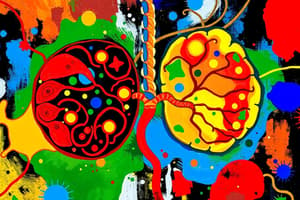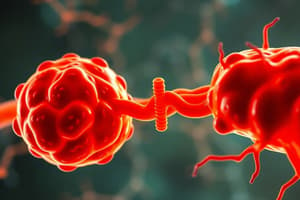Podcast
Questions and Answers
How does the conversion of C-C and C-H bonds into C-O and H-O bonds contribute to ATP production?
How does the conversion of C-C and C-H bonds into C-O and H-O bonds contribute to ATP production?
- By directly synthesizing ATP molecules through bond formation.
- By releasing energy because C-O and H-O bonds are more stable and lower in energy than C-C and C-H bonds. (correct)
- By increasing the electronegativity of carbon, which attracts ATP.
- By facilitating the direct transfer of electrons to oxygen without the need for electron carriers.
Why is it necessary for electrons to be transferred to NADH and FADH2 before reaching oxygen in cellular respiration?
Why is it necessary for electrons to be transferred to NADH and FADH2 before reaching oxygen in cellular respiration?
- To increase the overall ATP yield by maximizing electron transfer efficiency.
- To gradually release energy in a controlled manner, preventing cellular damage from a sudden energy surge. (correct)
- To prevent the electrons from being consumed by other cellular processes.
- To ensure that oxygen becomes fully reduced before interacting with other molecules.
During cellular respiration, how does carbon's oxidation state change as it transfers electrons to oxygen?
During cellular respiration, how does carbon's oxidation state change as it transfers electrons to oxygen?
- It decreases from +4 to 0, releasing energy in the process.
- It remains constant, ensuring no energy is lost during the process.
- It fluctuates randomly depending on the availability of oxygen.
- It increases from 0 in glucose to +4 in $CO_2$, gradually releasing energy. (correct)
In the context of cellular respiration, what is the primary role of NAD+ and FAD?
In the context of cellular respiration, what is the primary role of NAD+ and FAD?
Why do food molecules rich in C-C and C-H bonds provide excellent sources of energy during cellular respiration?
Why do food molecules rich in C-C and C-H bonds provide excellent sources of energy during cellular respiration?
During glycolysis, why is the process considered anaerobic?
During glycolysis, why is the process considered anaerobic?
What is the role of the citric acid cycle in the complete oxidation of glucose?
What is the role of the citric acid cycle in the complete oxidation of glucose?
How does the electron transport chain (ETC) contribute to ATP production in oxidative phosphorylation?
How does the electron transport chain (ETC) contribute to ATP production in oxidative phosphorylation?
What role does oxygen play in the electron transport chain?
What role does oxygen play in the electron transport chain?
How does ATP synthase utilize the proton gradient generated by the electron transport chain to produce ATP?
How does ATP synthase utilize the proton gradient generated by the electron transport chain to produce ATP?
What is the typical net ATP yield from a single glucose molecule in cellular respiration?
What is the typical net ATP yield from a single glucose molecule in cellular respiration?
In DNA technology, what is the function of plasmids?
In DNA technology, what is the function of plasmids?
What is the purpose of using antibiotic resistance genes in plasmids during bacterial transformation?
What is the purpose of using antibiotic resistance genes in plasmids during bacterial transformation?
What is the role of restriction enzymes in the process of inserting new genes into plasmids?
What is the role of restriction enzymes in the process of inserting new genes into plasmids?
Why is DNA ligase essential when inserting a new gene into a plasmid?
Why is DNA ligase essential when inserting a new gene into a plasmid?
In the context of bacterial transformation, what does it mean for bacteria to be 'transformed'?
In the context of bacterial transformation, what does it mean for bacteria to be 'transformed'?
In a lab experiment using pGLO, what does the ampicillin resistance gene (bla) provide to the transformed E. coli?
In a lab experiment using pGLO, what does the ampicillin resistance gene (bla) provide to the transformed E. coli?
What is the purpose of the regulatory system (araC) in the pGLO plasmid?
What is the purpose of the regulatory system (araC) in the pGLO plasmid?
Why is it crucial for restriction enzymes to work in an environment similar to that of the bacterium from which they were derived?
Why is it crucial for restriction enzymes to work in an environment similar to that of the bacterium from which they were derived?
In DNA cloning, why might transformed bacteria lose the plasmid over time if grown without a selective pressure like ampicillin?
In DNA cloning, why might transformed bacteria lose the plasmid over time if grown without a selective pressure like ampicillin?
Flashcards
Cellular Respiration
Cellular Respiration
Series of catabolic reactions converting food molecule energy into ATP.
Substrate-level phosphorylation
Substrate-level phosphorylation
Transfer of a phosphate group from an organic molecule to ADP to make ATP.
Oxidative phosphorylation
Oxidative phosphorylation
ATP production using energy from electrons transferred through the electron transport chain, coupled with chemiosmosis.
Energy Location in Glucose
Energy Location in Glucose
Signup and view all the flashcards
Electron transfer to O2
Electron transfer to O2
Signup and view all the flashcards
Oxidation
Oxidation
Signup and view all the flashcards
Reduction
Reduction
Signup and view all the flashcards
Oxidation States of Carbon
Oxidation States of Carbon
Signup and view all the flashcards
Glycolysis
Glycolysis
Signup and view all the flashcards
Pyruvate Oxidation
Pyruvate Oxidation
Signup and view all the flashcards
Citric Acid Cycle
Citric Acid Cycle
Signup and view all the flashcards
Oxidative Phosphorylation
Oxidative Phosphorylation
Signup and view all the flashcards
Electron Transport Chain
Electron Transport Chain
Signup and view all the flashcards
Chemiosmosis (ATP synthesis)
Chemiosmosis (ATP synthesis)
Signup and view all the flashcards
Plasmids
Plasmids
Signup and view all the flashcards
Restriction Enzymes
Restriction Enzymes
Signup and view all the flashcards
Antibiotic resistance gene
Antibiotic resistance gene
Signup and view all the flashcards
Restriction Enzyme Digestion
Restriction Enzyme Digestion
Signup and view all the flashcards
Green fluorescent protein (GFP)
Green fluorescent protein (GFP)
Signup and view all the flashcards
Ampicillin resistance gene (bla)
Ampicillin resistance gene (bla)
Signup and view all the flashcards
Study Notes
Cellular Respiration
- Series of catabolic reactions converting food molecule energy into ATP energy.
ATP Production
- Occurs through substrate-level phosphorylation and oxidative phosphorylation.
Substrate-Level Phosphorylation
- An organic molecule directly transfers a phosphate group (Pi) to ADP to make ATP.
- It produces only a small amount of the total ATP generated in cellular respiration.
- Takes place during glycolysis and the citric acid cycle.
Oxidative Phosphorylation
- Major ATP producer (88%) and occurs in stage 4 of cellular respiration.
- ATP is produced using energy from electrons transferred through the electron transport chain (ETC).
- Coupled with chemiosmosis.
Energy in Glucose
- Stored in chemical bonds, specifically C-H and C-C bonds.
- These bonds hold high-energy electrons released during cellular respiration.
Energy Release from Bond Conversion
- Converting C-C and C-H bonds into C-O and H-O bonds releases energy.
- C-O and H-O bonds are more stable with less energy than C-C and C-H bonds.
- The process involves oxidation, where the carbon atom loses electrons.
- Products such as CO2 and H2O become more stable than original reactants.
- The energy difference is released in the form of ATP.
Electron Transfer to Oxygen
- Electrons are not directly passed to O₂ to prevent too much energy release which could damage the cell.
- First, they are transferred to NADH and FADH₂, which carry them to the electron transport chain (ETC).
Redox Reactions
- Oxidation involves the loss of electrons (LEO).
- Reduction involves the gain of electrons (GER).
- Electron transfers always occur between atoms.
- Electron transfer happens spontaneously from less to more electronegative atoms.
- Oxidation and reduction are coupled reactions.
- Reduced forms have more chemical energy than oxidized forms.
- Nicotinamide adenine dinucleotide (NAD) and Flavin adenine dinucleotide (FAD) are two important electron carriers.
NAD+
- Most commonly used electron carrier in cellular respiration.
- NAD+/NADH picks up/drops off 2 electrons and is diffusible.
- FAD/FADH2 also carry pairs of electrons.
Oxidation States of Carbon
- Carbon's oxidation state depends on electron sharing, particularly with electronegative oxygen.
- Carbon loses electrons to oxygen during respiration, increasing its oxidation state from 0 (glucose) to +4 (CO₂).
- Gradual oxidation releases energy captured as ATP.
- Food molecules with C-C and C-H bonds have high potential energy because electrons are not tightly held by oxygen.
- Food molecules are excellent sources of energy transferred to oxygen during respiration.
Four Stages of Cellular Respiration
- Glycolysis, pyruvate oxidation, citric acid cycle, oxidative phosphorylation
Glycolysis
- Takes place in the cytoplasm.
- Glucose is broken down into pyruvate, ATP, and reduced electron carriers.
- Glucose is only partially oxidized and some energy held in its chemical bonds is released.
- Oxygen is not consumed, making it anaerobic.
- The net yield per mole of glucose is 2 pyruvate, 2 ATP, and 2 NADH.
Glycolysis steps
- Carbon backbone, phosphorylation, oxidation state
Carbon Backbone
- Glucose (6C) splits into two 3C molecules (G3P) and ends as pyruvate (3C).
Phosphorylation
- 2 ATP is used and 4 ATP are made, with a net gain of 2 ATP.
Oxidation State
- Step 6 is the only step involving oxidation (NADH formation).
- Pyruvate is partially reduced and can be further oxidized in the Krebs cycle.
Pyruvate Oxidation
- This occurs in the mitochondria and converts pyruvate (from glycolysis) in acetyl-CoA, which enters the Krebs cycle.
- Produces reduced electron carriers (NADH) and CO2 in the mitochondrial matrix.
Pyruvate Processing
- Each 3-carbon pyruvate undergoes decarboxylation, NADH formation, and coenzyme A attachment.
- Decarboxylation removes one carbon from pyruvate, forming CO₂ (waste product).
- Electrons lost during this process are donated to NAD+, reducing it to NADH.
- Coenzyme A (CoA) then binds to the remaining 2-carbon molecule, forming Acetyl-CoA.
Acetyl-CoA synthesis
- Products are 2 NADH, 2 CO2, and 2 Acetyl-CoA.
Citric Acid Cycle
- Completes glucose breakdown by oxidizing Acetyl-CoA into CO₂, and generates NADH, FADH₂, and ATP.
- Occurs in the mitochondrial matrix.
- The cycle begins with Acetyl-CoA and regenerates oxaloacetate.
- Chemical potential energy stored in acetyl-CoA is then moved into NADH and FADH2.
- All six carbons from initial glucose are oxidized to CO₂, which is released as waste, dismantling the glucose skeleton completely.
Products per Acetyl-CoA turn
- 3 NADH (electron carrier).
- 1 FADH₂ (electron carrier).
- 1 ATP (energy).
- 2 CO₂ (waste product).
Products at the End of the Citric Acid Cycle
- 2 ATP.
- 6 NADH.
- 2 FADH2.
- 4 CO2.
Oxidative Phosphorylation
- ATP is produced using energy from electron carriers through the electron transport chain in the inner mitochondrial membrane.
- Oxygen is required as the final electron acceptor and this is the final stage of cellular respiration.
- Electron transport chain, chemiosmosis
Electron Transport Chain
- Creates a proton gradient.
Chemiosmosis
- (ATP synthesis) uses the gradient to make ATP.
Electron Transport Chain (Details)
- Series of protein complexes in the inner mitochondrial membrane that takes electrons from NADH & FADH₂ to oxygen (O₂).
- ETC complexes increasing electronegativity, transfers electrons, and pumps protons with four large protein complexes (I to IV) in the inner mitochondrial membrane.
Electron Transport Chain (steps)
- NADH and FADH₂ donate electrons to the ETC.
- Electrons move through Complexes I-IV, releasing energy.
- Proton (H⁺) ions are pumped into the intermembrane space, creating a proton gradient.
- At Complex IV, electrons combine with O₂ and H⁺ to form water (H₂O).
- O₂ is the final electron acceptor, making this process aerobic.
Proton Movement
- Facilitated diffusion back into matrix via the ATP synthase drives formation of ATP from ADP + Pᵢ.
Proton Gradient
- Protons flow down concentration gradient and power ATP synthase, converting one energy form into energy in ATP bonds.
- It is a source of potential (stored) energy.
ATP Synthase
- An enzyme complex in the inner mitochondrial membrane.
- Uses energy from the proton gradient (H⁺) created by the electron transport chain (ETC) to synthesize ATP.
- Potential energy stored in the proton gradient is converted to mechanical energy (kinetic) as protons move down their concentration gradient through ATP synthase.
- Changes in conformation of the subunit in the mitochondrial matrix catalyze the reaction to converting ADP and Pᵢ to ATP.
Flow of Energy in Cellular Respiration
- Glucose transforms to electron carriers then to a proton gradient and ultimately to ATP.
- A single glucose molecule produces 32 ATP molecules.
Energy Observations
- To determine energy content, count C-H, C-O, and C=O bonds.
- The more C-H and C-C bonds, the higher the energy of the molecule.
- C=O bonds are not high-energy bonds.
- Energy content order, from highest to lowest: alcohol > carbonyl > carboxylic acid.
Cloning
- Cloning uses bacteria to make numerous copies of DNA.
- Molecular cloning involves copying a gene or DNA fragment, inserting it into a host organism (like bacteria) for research.
- Organismal cloning creates a genetically identical copy.
Plasmids
- Bacterial 'mini-chromosomes'.
- Small, circular pieces of double-stranded DNA in bacteria and eukaryotes.
- In laboratories, plasmids act as carriers, or vectors, to insert foreign DNA into bacteria.
- Bacteria that take up plasmids are transformed.
- Transformed bacteria express plasmid genes.
- The plasmid independently replicates and has its own origin of replication (Ori).
- Under the right situations plasmids are transferred between cells.
- Certain cells carry genes that provide special properties or selective advantages: antibiotic resistance or ability to metabolize a food source.
Inserting New Genes Into Plasmids
- Extra DNA is inserted into plasmids using restriction enzymes.
- Enzymes cut DNA at specific motifs to add a DNA piece.
- Bacteria have a defense system that uses restriction enzymes to cut up viral DNA before taking over the cell.
- A bacterium protects DNA by adding methyl groups on As and Cs.
- Restriction enzymes cut DNA in a zigzag, leaving unpaired nucleotides that makes it easy for segments to stick.
Cloning Steps
- The plasmid and target DNA are cut with restriction enzymes.
- The new gene is inserted and sealed with DNA ligase.
- Recombinant plasmids are introduced into bacteria via transformation.
- Transformed bacteria are selected using antibiotic resistance.
- Insertion confirmed with PCR or DNA sequencing.
Determining if Bacteria Have Been Transformed
- (Most common) Antibiotic selection is used with a selectable marker gene for ampicillin resistance.
- The plasmid carries a gene for antibiotic resistance (e.g., ampicillin resistance).
- Bacteria are grown on agar plates with the antibiotic.
- Only transformed survive because they have resistance, while non-transformed die.
Using Transformed Cells
- Extract the plasmid to sequence the cloned fragment.
- Extract/produce protein to analyze biochemically or use in biochemical/industrial applications.
DNA Cloning Summary
- DNA fragment of interest: to be cloned needs DNA ligase that repairs the cuts.
- Transformed cells can grow without ampicillin, but cells may lose the plasmid without selective pressure.
Lab Experiment: Transformation with pGLO
- Green fluorescent protein (GFP) derived from jellyfish makes transformed bacteria glow under UV light.
- Ampicillin resistance gene (bla) with the β-lactamase enzyme provides resistance to ampicillin
Regulatory system (araC)
- Controls GFP expression under right conditions.
Restriction Enzyme Digestion of Plasmid DNA.
- Enzymes recognize base sequences in DNA and cleave the sugar-phosphate backbone in or near the sequence.
- Functions in an environment found in the bacterium, with the correct pH, salt, and temperature.
Studying That Suits You
Use AI to generate personalized quizzes and flashcards to suit your learning preferences.




